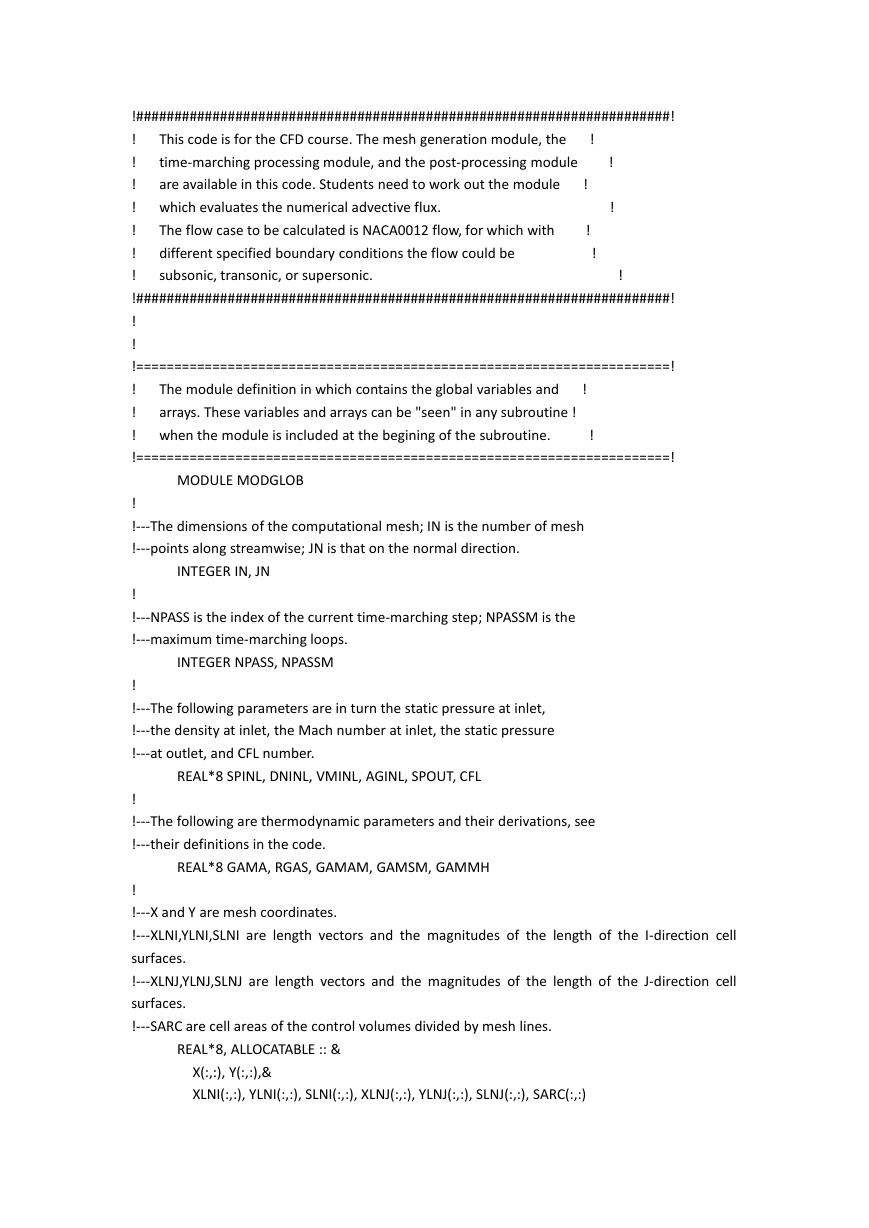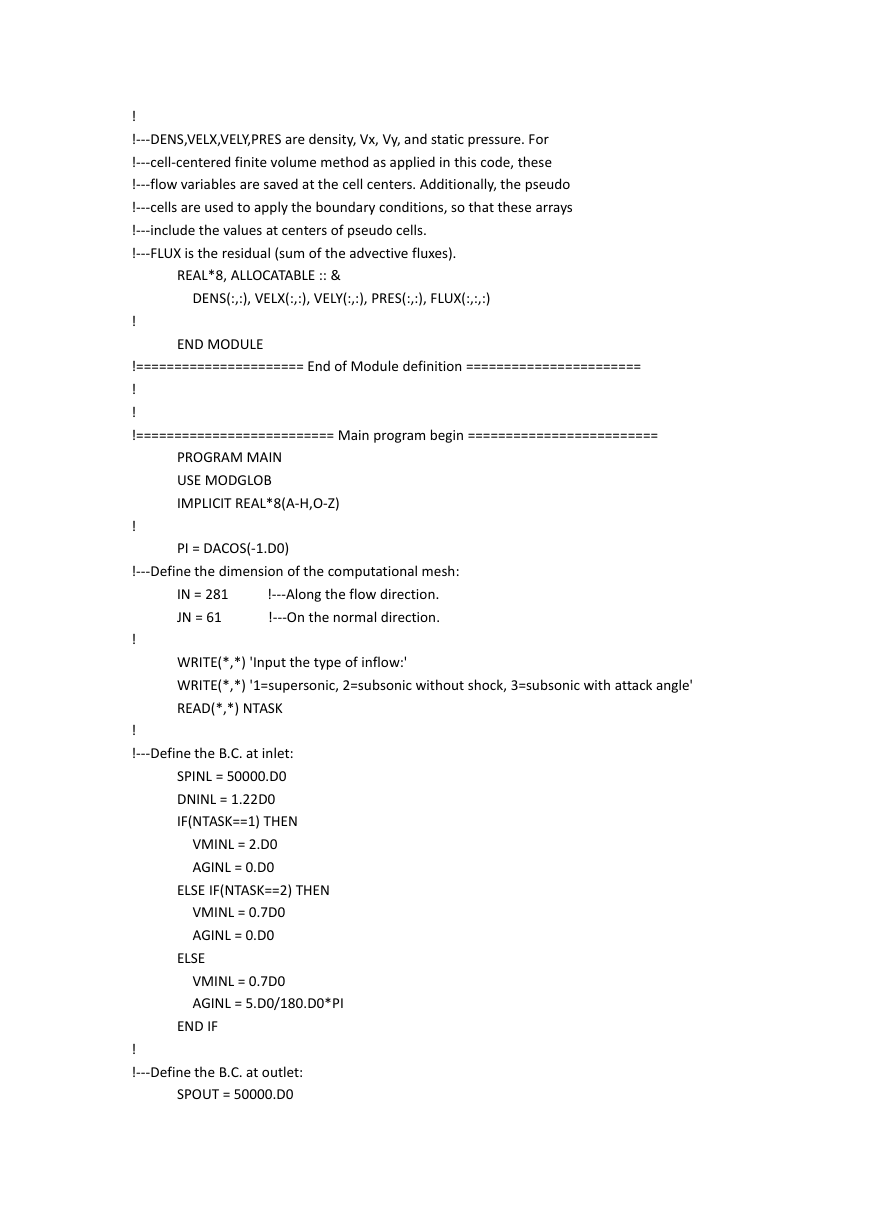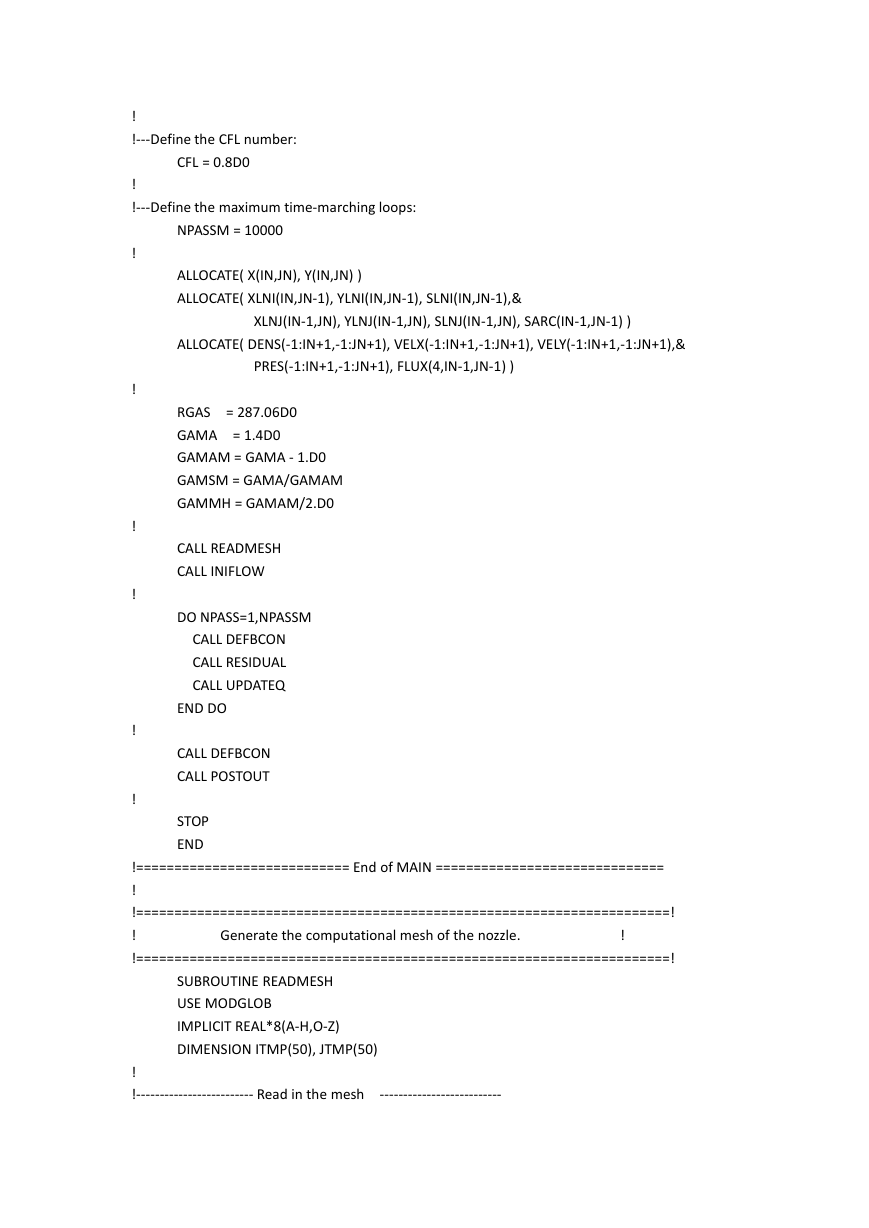!
!
!
!
This code is for the CFD course. The mesh generation module, the
time-marching processing module, and the post-processing module
are available in this code. Students need to work out the module
which evaluates the numerical advective flux.
The flow case to be calculated is NACA0012 flow, for which with
different specified boundary conditions the flow could be
subsonic, transonic, or supersonic.
!######################################################################!
!
!
!
!
!
!
!
!######################################################################!
!
!
!======================================================================!
!
!
!
!======================================================================!
The module definition in which contains the global variables and
arrays. These variables and arrays can be "seen" in any subroutine !
when the module is included at the begining of the subroutine.
!
!
!
!
!
MODULE MODGLOB
!
!---The dimensions of the computational mesh; IN is the number of mesh
!---points along streamwise; JN is that on the normal direction.
INTEGER IN, JN
!
!---NPASS is the index of the current time-marching step; NPASSM is the
!---maximum time-marching loops.
INTEGER NPASS, NPASSM
!
!---The following parameters are in turn the static pressure at inlet,
!---the density at inlet, the Mach number at inlet, the static pressure
!---at outlet, and CFL number.
REAL*8 SPINL, DNINL, VMINL, AGINL, SPOUT, CFL
!
!---The following are thermodynamic parameters and their derivations, see
!---their definitions in the code.
REAL*8 GAMA, RGAS, GAMAM, GAMSM, GAMMH
!
!---X and Y are mesh coordinates.
!---XLNI,YLNI,SLNI are length vectors and the magnitudes of the length of the I-direction cell
surfaces.
!---XLNJ,YLNJ,SLNJ are length vectors and the magnitudes of the length of the J-direction cell
surfaces.
!---SARC are cell areas of the control volumes divided by mesh lines.
REAL*8, ALLOCATABLE :: &
X(:,:), Y(:,:),&
XLNI(:,:), YLNI(:,:), SLNI(:,:), XLNJ(:,:), YLNJ(:,:), SLNJ(:,:), SARC(:,:)
�
!
!---DENS,VELX,VELY,PRES are density, Vx, Vy, and static pressure. For
!---cell-centered finite volume method as applied in this code, these
!---flow variables are saved at the cell centers. Additionally, the pseudo
!---cells are used to apply the boundary conditions, so that these arrays
!---include the values at centers of pseudo cells.
!---FLUX is the residual (sum of the advective fluxes).
REAL*8, ALLOCATABLE :: &
DENS(:,:), VELX(:,:), VELY(:,:), PRES(:,:), FLUX(:,:,:)
!
END MODULE
!====================== End of Module definition =======================
!
!
!========================== Main program begin =========================
PROGRAM MAIN
USE MODGLOB
IMPLICIT REAL*8(A-H,O-Z)
!
PI = DACOS(-1.D0)
!---Define the dimension of the computational mesh:
IN = 281
JN = 61
!---Along the flow direction.
!---On the normal direction.
!
WRITE(*,*) 'Input the type of inflow:'
WRITE(*,*) '1=supersonic, 2=subsonic without shock, 3=subsonic with attack angle'
READ(*,*) NTASK
!
!---Define the B.C. at inlet:
SPINL = 50000.D0
DNINL = 1.22D0
IF(NTASK==1) THEN
VMINL = 2.D0
AGINL = 0.D0
ELSE IF(NTASK==2) THEN
VMINL = 0.7D0
AGINL = 0.D0
ELSE
VMINL = 0.7D0
AGINL = 5.D0/180.D0*PI
END IF
!
!---Define the B.C. at outlet:
SPOUT = 50000.D0
�
!
!---Define the CFL number:
CFL = 0.8D0
!
!---Define the maximum time-marching loops:
NPASSM = 10000
!
!
!
!
!
!
ALLOCATE( X(IN,JN), Y(IN,JN) )
ALLOCATE( XLNI(IN,JN-1), YLNI(IN,JN-1), SLNI(IN,JN-1),&
XLNJ(IN-1,JN), YLNJ(IN-1,JN), SLNJ(IN-1,JN), SARC(IN-1,JN-1) )
ALLOCATE( DENS(-1:IN+1,-1:JN+1), VELX(-1:IN+1,-1:JN+1), VELY(-1:IN+1,-1:JN+1),&
PRES(-1:IN+1,-1:JN+1), FLUX(4,IN-1,JN-1) )
= 287.06D0
RGAS
GAMA = 1.4D0
GAMAM = GAMA - 1.D0
GAMSM = GAMA/GAMAM
GAMMH = GAMAM/2.D0
CALL READMESH
CALL INIFLOW
DO NPASS=1,NPASSM
CALL DEFBCON
CALL RESIDUAL
CALL UPDATEQ
END DO
CALL DEFBCON
CALL POSTOUT
STOP
END
!============================ End of MAIN ==============================
!
!======================================================================!
!
!======================================================================!
Generate the computational mesh of the nozzle.
!
SUBROUTINE READMESH
USE MODGLOB
IMPLICIT REAL*8(A-H,O-Z)
DIMENSION ITMP(50), JTMP(50)
!
!------------------------- Read in the mesh --------------------------
�
OPEN(61,FILE='ingrid.dat',FORM='UNFORMATTED')
READ(61) NBKM
READ(61)((ITMP(N),JTMP(N)),N=1,NBKM)
DO N=1,NBKM
READ(61) ((X(I,J),I=1,IN),J=1,JN),&
((Y(I,J),I=1,IN),J=1,JN)
END DO
CLOSE(61)
!
OPEN(71,FILE='pltgrid.plt')
WRITE(71,*) 'TITLE="NONAME"'
WRITE(71,*) 'VARIABLES="X","Y"'
WRITE(71,*) 'ZONE T="NONAME", I=',IN,',J=',JN,', F=POINT'
DO J=1,JN
DO I=1,IN
WRITE(71,*) X(I,J), Y(I,J)
END DO
END DO
CLOSE(71)
!
!------------ Calculate the surface length vectors and -----------------
!------------ the areas of 2D control volumes divided -----------------
!------------ by mesh lines.
-----------------
21
!
22
!
DO 21 J=1,JN-1
DO 21 I=1,IN
XLNI(I,J) = Y(I,J+1) - Y(I,J
YLNI(I,J) = X(I,J
SLNI(I,J) = DSQRT( XLNI(I,J)*XLNI(I,J) + YLNI(I,J)*YLNI(I,J) )
)
) - X(I,J+1)
CONTINUE
DO 22 J=1,JN
DO 22 I=1,IN-1
XLNJ(I,J) = Y(I
YLNJ(I,J) = X(I+1,J) - X(I
SLNJ(I,J) = DSQRT( XLNJ(I,J)*XLNJ(I,J) + YLNJ(I,J)*YLNJ(I,J) )
,J) - Y(I+1,J)
,J)
CONTINUE
DO 23 J=1,JN-1
DO 23 I=1,IN-1
I1 = I + 1
J1 = J + 1
SARC(I,J) = 0.5D0*( DABS( ( X(I ,J ) - X(I1,J ) )*Y(I1,J1)&
+( X(I1,J ) - X(I1,J1) )*Y(I ,J )&
+( X(I1,J1) - X(I ,J ) )*Y(I1,J ) )&
�
+ DABS( ( X(I ,J ) - X(I1,J1) )*Y(I ,J1)&
+( X(I1,J1) - X(I ,J1) )*Y(I ,J )&
+( X(I ,J1) - X(I ,J ) )*Y(I1,J1) ) )
23
!
CONTINUE
RETURN
END
!========================== End of READMESH ============================
!
!======================================================================!
!
!
!======================================================================!
The following method generates a mean flow field.
Generate the initial flow field.
!
!
SUBROUTINE INIFLOW
USE MODGLOB
IMPLICIT REAL*8(A-H,O-Z)
DNINI = DNINL
SPINI = SPINL
VTINI = VMINL*DSQRT(GAMA*SPINL/DNINL)
DO 11 J=1,JN-1
DO 11 I=1,IN-1
DENS(I,J) = DNINI
VELX(I,J) = VTINI*DCOS(AGINL)
VELY(I,J) = VTINI*DSIN(AGINL)
PRES(I,J) = SPINI
CONTINUE
RETURN
END
!
!
11
!
!=========================== End of INIFLOW ============================
!
!======================================================================!
!
!======================================================================!
Define the boundary conditions.
!
SUBROUTINE DEFBCON
USE MODGLOB
IMPLICIT REAL*8(A-H,O-Z)
!
!---Define the B.C. at far field boundary(J=JN):
TEMP = 1.D0 + GAMMH*VMINL**2
TPINL = SPINL*TEMP**GAMSM
STINL = SPINL/DNINL/RGAS
�
TTINL = STINL*TEMP
VTINL = VMINL*DSQRT(GAMA*RGAS*STINL)
DO 11 I=1,IN-1
SNX = XLNJ(I,JN)/SLNJ(I,JN)
SNY = YLNJ(I,JN)/SLNJ(I,JN)
VNFFB = VELX(I,JN-1)*SNX + VELY(I,JN-1)*SNY
VTFFB = DSQRT(VELX(I,JN-1)**2+VELY(I,JN-1)**2)
SNFFB = DSQRT(GAMA*PRES(I,JN-1)/DENS(I,JN-1))
VMCHB = VTFFB/SNFFB
IF(VNFFB<0.D0) THEN
IF(VMCHB>=1.D0) THEN
DENS(I,JN) = DNINL
VELX(I,JN) = VTINL*DCOS(AGINL)
VELY(I,JN) = VTINL*DSIN(AGINL)
PRES(I,JN) = SPINL
ELSE
SPI = DMIN1( PRES(I,JN-1), TPINL )
TMP = (TPINL/SPI)**(1.D0/GAMSM)
VMI = DSQRT((TMP-1.D0)/GAMMH)
STI = TTINL/TMP
VTI = VMI*DSQRT(GAMA*RGAS*STI)
DENS(I,JN) = SPI/STI/RGAS
VELX(I,JN) = VTI*DCOS(AGINL)
VELY(I,JN) = VTI*DSIN(AGINL)
PRES(I,JN) = SPI
END IF
ELSE
IF(VMCHB>=1.D0) THEN
PRES(I,JN) = PRES(I,JN-1)
ELSE
PRES(I,JN) = SPOUT
END IF
DENS(I,JN) = DENS(I,JN-1)
VELX(I,JN) = VELX(I,JN-1)
VELY(I,JN) = VELY(I,JN-1)
END IF
CONTINUE
11
!
!---Define the wall B.C. at the airfoil surface(J=1):
DO 21 I=61,220
VNORM = VELX(I,1)*XLNJ(I,1) + VELY(I,1)*YLNJ(I,1)
VTEMP = 2.D0*VNORM/SLNJ(I,1)/SLNJ(I,1)
DENS(I,0) = DENS(I,1)
VELX(I,0) = VELX(I,1) - VTEMP*XLNJ(I,1)
�
VELY(I,0) = VELY(I,1) - VTEMP*YLNJ(I,1)
PRES(I,0) = PRES(I,1)
CONTINUE
21
!
!---Define the internal B.C.(J=1) :
!---The first layer:
DO 31 I=1,60
DENS(I,0) = DENS(281-I,1)
VELX(I,0) = VELX(281-I,1)
VELY(I,0) = VELY(281-I,1)
PRES(I,0) = PRES(281-I,1)
CONTINUE
31
!
!----The second layer:
DO 32 I=1,60
DENS(I,-1) = DENS(281-I,2)
VELX(I,-1) = VELX(281-I,2)
VELY(I,-1) = VELY(281-I,2)
PRES(I,-1) = PRES(281-I,2)
CONTINUE
32
!
!---Define the internal B.C.(J=1) :
!---The first layer:
DO 41 I=221,IN-1
DENS(I,0) = DENS(281-I,1)
VELX(I,0) = VELX(281-I,1)
VELY(I,0) = VELY(281-I,1)
PRES(I,0) = PRES(281-I,1)
CONTINUE
41
!
!----The second layer:
DO 42 I=221,IN-1
DENS(I,-1) = DENS(281-I,2)
VELX(I,-1) = VELX(281-I,2)
VELY(I,-1) = VELY(281-I,2)
PRES(I,-1) = PRES(281-I,2)
CONTINUE
42
!
!---Define the outlet B.C.(I=1) :
DO 51 J=1,JN-1
VTBCD = DSQRT(VELX(1,J)**2+VELY(1,J)**2)
SNBCD = DSQRT(GAMA*PRES(1,J)/DENS(1,J))
VMCHB = VTBCD/SNBCD
IF(VMCHB>=1.D0) THEN
�
PRES(0,J) = PRES(1,J)
ELSE
PRES(0,J) = SPOUT
END IF
DENS(0,J) = DENS(1,J)
VELX(0,J) = VELX(1,J)
VELY(0,J) = VELY(1,J)
CONTINUE
51
!
!---Define the outlet B.C.(I=IN) :
DO 52 J=1,JN-1
VTBCD = DSQRT(VELX(IN-1,J)**2+VELY(IN-1,J)**2)
SNBCD = DSQRT(GAMA*PRES(IN-1,J)/DENS(IN-1,J))
VMCHB = VTBCD/SNBCD
IF(VMCHB>=1.D0) THEN
PRES(IN,J) = PRES(IN-1,J)
ELSE
PRES(IN,J) = SPOUT
END IF
DENS(IN,J) = DENS(IN-1,J)
VELX(IN,J) = VELX(IN-1,J)
VELY(IN,J) = VELY(IN-1,J)
52
!
CONTINUE
RETURN
END
!=========================== End of DEFBCON ============================
!
!======================================================================!
!
!======================================================================!
Calculate the residual which is the sum of numerical flux.
!
SUBROUTINE RESIDUAL
USE MODGLOB
IMPLICIT REAL*8(A-H,O-Z)
!
!
RETURN
END
!=========================== End of ADVFLUX ============================
!
!======================================================================!
!
!
!======================================================================!
Update the conservative variables at time level n+1 using
a simple one-step time marching scheme.
!
!
�
















 2023年江西萍乡中考道德与法治真题及答案.doc
2023年江西萍乡中考道德与法治真题及答案.doc 2012年重庆南川中考生物真题及答案.doc
2012年重庆南川中考生物真题及答案.doc 2013年江西师范大学地理学综合及文艺理论基础考研真题.doc
2013年江西师范大学地理学综合及文艺理论基础考研真题.doc 2020年四川甘孜小升初语文真题及答案I卷.doc
2020年四川甘孜小升初语文真题及答案I卷.doc 2020年注册岩土工程师专业基础考试真题及答案.doc
2020年注册岩土工程师专业基础考试真题及答案.doc 2023-2024学年福建省厦门市九年级上学期数学月考试题及答案.doc
2023-2024学年福建省厦门市九年级上学期数学月考试题及答案.doc 2021-2022学年辽宁省沈阳市大东区九年级上学期语文期末试题及答案.doc
2021-2022学年辽宁省沈阳市大东区九年级上学期语文期末试题及答案.doc 2022-2023学年北京东城区初三第一学期物理期末试卷及答案.doc
2022-2023学年北京东城区初三第一学期物理期末试卷及答案.doc 2018上半年江西教师资格初中地理学科知识与教学能力真题及答案.doc
2018上半年江西教师资格初中地理学科知识与教学能力真题及答案.doc 2012年河北国家公务员申论考试真题及答案-省级.doc
2012年河北国家公务员申论考试真题及答案-省级.doc 2020-2021学年江苏省扬州市江都区邵樊片九年级上学期数学第一次质量检测试题及答案.doc
2020-2021学年江苏省扬州市江都区邵樊片九年级上学期数学第一次质量检测试题及答案.doc 2022下半年黑龙江教师资格证中学综合素质真题及答案.doc
2022下半年黑龙江教师资格证中学综合素质真题及答案.doc